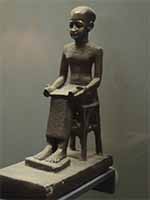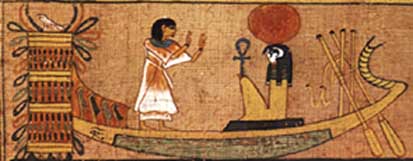Saqqara
And the Mysterious Book of the Dead

It was at Saqqara, near Memphis, that the first pyramid of Egypt was erected. The architect Imhotep, who was later deified, built this pyramid for the Pharaoh Djoser. In reality, the pharaoh originally built a square mastaba, the shape of which resembles a truncated low pyramid, and then decided to enlarge it by superimposing another smaller mastaba on top of it until the structure took it's current shape formed by six steps and reaching a height of 60 meters. The mastaba (Arabic word indicating a stone seat in the shape of a parallelepiped) is the primitive model of tomb, typical of this region of Egypt. The structure, reminiscent of that of a dwelling, is linked to the belief in a destiny of the soul in the afterlife, and represents a symbolic link between life and death. On the outside, it is made up of a massive set of stones forming a low truncated pyramid, while inside there is a well containing the sarcophagus with the funerary furniture. To the east is the chapel which houses the altar for the offerings. At the bottom of the altar was generally located a stele, a sort of trompe-l'oeil door, which did not allow access to the well which led to the tomb itself. The well was closed by stones and the access was located at the top. The absence of written documents makes it difficult to have a precise knowledge of the site of Saqqara, which remains, however, one of the most ancient and imposing testimonies of the archaic culture of the people of the Nile.

By observing the complex project of the pyramid of Saqqara, one measure the genius of Imhotep, a sort of Leonardo of Antiquity, as one learn from the inscription engraved on the base of the statue of the pharaoh, where all his titles are indicated: Administrator of the Grand Palace, High Priest of Heliopolis, Builder, Sculptor and Creator of stone vases. It is perhaps because of this last activity of Imhotep that more than 40,000 vases and containers of all shapes and sizes were found in the great step pyramid. In this singular tomb, made up of around 200,000 tons of stone, archaeologists found the statue of the pharaoh as well as inscriptions and offerings in the funerary chamber: an important body of testimony which has not been found in the three pyramids of Giza.
The journey to the afterlife

The pyramid of Saqqara is surrounded by the ruins of a splendid set of buildings, also made by Imhotep. For a long part of Egyptian history, this site was a burial ground. This region is therefore one of the most interesting to understand the genesis of funeral practices in the oldest phase of the history of the people of the Nile. Boats, enclosed in brick chambers, have been found in tombs dating back to the First Dynasty. It is in these boats that the deceased was believed to be carrying out the “journey into the afterlife”. One find testimonies and representations of this trip in the Pyramid Texts of the pyramids from the 5th dynasty. However, near the Great Pyramid of Giza was found a boat measuring over 40 meters long, 5 meters wide and 9 meters high. The boat, dismantled, was located in a place where the pharaoh could have reassembled it with the help of magic and the collaboration of his personal army, formed of hundreds of shawabti.
The boat was driven by “the man with the face turned backwards”, a sort of Caron who had the task of accompanying the pharaoh in the afterlife, through the Field of Reeds which separated the world of the living from that of the dead. In the Pyramid Texts, one finds the symbol of the ladder, as a means to reach the reign of the dead: it is perhaps on this symbolism that the tradition rests to make the first pyramids with huge steps on the sides. The Book of the Dead thus celebrates the symbol of the ladder: “Homage to you, O Ladder who supports the golden vase of spirits (...). I set up a Ladder among the gods and I am a divine being among them (...). Remain erected, O Scale of Horus, by which Osiris ascended to heaven when he used his magic power on Ra”.
The mysterious Book of the Dead

An important source for better understanding the concept of life after death and the spirituality of the ancient Egyptians is the Book of the Dead. In reality, it is not exactly a book but a series of texts transcribed on papyrus and which were placed in the coffin of the deceased. Also called Book of Coming Forth by Day, this collection of funeral texts develops and revises the Pyramid Texts, the first known texts on the journey of the dead, which date back to the time of the Middle Kingdom.
The Book of the Dead teaches us that after death, each man went up to heaven to unite with the god of the Sun. But the mysteries of death were only accessible to man after being subjected to the “judgment of the dead”. This judgment served to determine whether, during his life, the deceased had respected the universal rules imposed on humans. Originally, the judge was Ra, the god of the Sun, but, from the 11th dynasty, this role was attributed to Osiris. During the judgment, Osiris was accompanied by forty-two judges who symbolized Egyptian provinces. According to the indications of the book, by appearing before the gods to be judged, the deceased had to proclaim his innocence and show that he had not committed any of the sins mentioned in the book. The rite of judgment also included the weighing of the heart of the deceased, which was carried out by placing the organ on one side of the scale and the ostrich feather of Maat, goddess of truth and justice, on the other. The god Thoth noted the result of the weighing and, if the weight exceeded that of the feather of Maat, the sinner suffered a tragic fate: he was devoured by a terrible monster (identified in some cases with Anubis, the jackal god). If, on the other hand, it was judged pure, it acceded to the reign of Osiris, a place of light and of celestial continuation of the terrestrial life.
The Book of the Dead was usually placed in a box decorated with the effigy of Osiris, or in the coffin, or in the strips of the mummy. Many texts have been found written in hieroglyphs, in demotic or hieratic writing. They are mainly collections of invocations and magical incantations, accompanied by illustrations, the reading of which was supposed to encourage travel to the afterlife. The text was read by a priest according to a very precise rite. The purpose of this rite was to allow the deceased to travel “freely” into the kingdom of the dead, and to help them obtain everything they needed in their eternal home.
A religion not based on a book
Contrary to what one might think, these collections of texts were not for the Egyptians a sacred book, like the Bible, the Quran or the Vedas. The only thing they have in common with the sacred books is their divine inspiration. The Book of the Dead is introduced by a chapter on “Formulas to be pronounced on the day of the funeral, on arriving at the tomb and before leaving”. It includes practices and instructions constituting an important testimony of the universe, especially mythical more than religious, of the Egyptians. Here are a few fragments: “My arrival among those who inhabit the horizon is greeted with cries of jubilation, and those who inhabit the Duat in this mummy form sing my praises (...). I rise like a venerable god, Lord of the Great Abode, at the sight of which the gods rejoice (...). O father! O brother! O mother Isis! I am wrapped in the strips and I see. I joined those who got rid of the strips and who see Osiris”.









































































































































































































































































































































